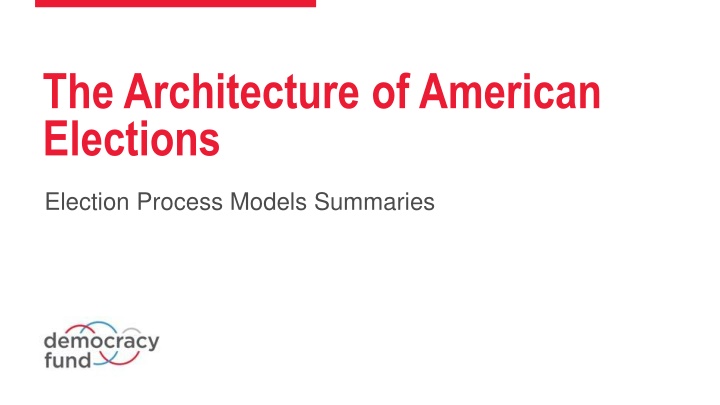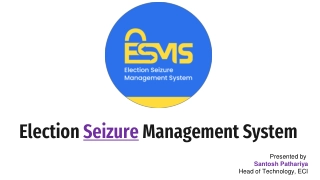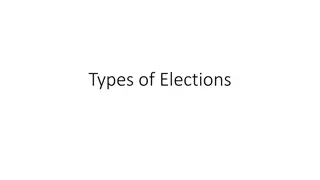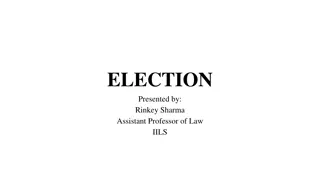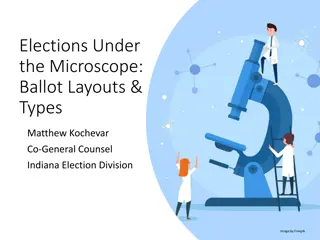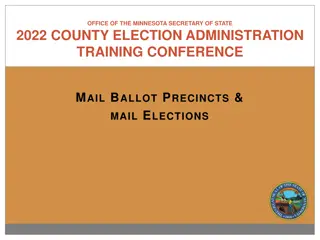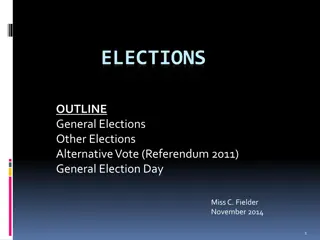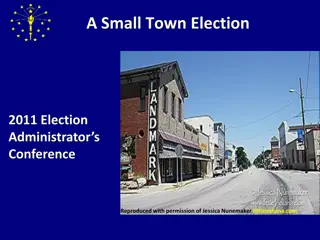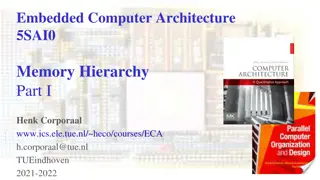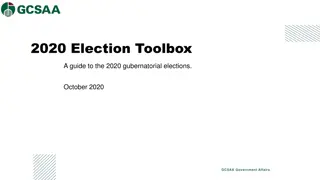The Architecture of American Elections: A Comprehensive Overview
"Explore the intricate process of administering elections in the United States through 'The Architecture of American Elections,' a detailed document outlining the functional stages from pre-voting to counting. Learn about maintaining geographic data, updating voter addresses, and processing ballot packages. Dive into the essential tasks election officials undertake to ensure a smooth electoral process."
Download Presentation

Please find below an Image/Link to download the presentation.
The content on the website is provided AS IS for your information and personal use only. It may not be sold, licensed, or shared on other websites without obtaining consent from the author.If you encounter any issues during the download, it is possible that the publisher has removed the file from their server.
You are allowed to download the files provided on this website for personal or commercial use, subject to the condition that they are used lawfully. All files are the property of their respective owners.
The content on the website is provided AS IS for your information and personal use only. It may not be sold, licensed, or shared on other websites without obtaining consent from the author.
E N D
Presentation Transcript
The Architecture of American Elections Election Process Models Summaries
What is this? Recently years of effort culminated in the publication of a comprehensive document, The Architecture of American Elections. This is the first work of its kind offering a thorough summation of the functional stages necessary to administer an election in the United States. That work is fairly technical, so this slide deck was created as a gateway to the more complex document for a small subset of the process figures. 2
#1: Pre-Voting #2: Voting Activity #3: Counting 4
Process Contents: Maintain Geographic Data (Figure 3) Vote in Person (Figure 10) Maintain Election District Boundaries (Figure 16) Update Voter Addresses Under the NVRA (Figure 25) Prepare Logic & Accuracy (Figure 40) Receive and Process Ballot Packages (Figure 48) 5
These will all be available on electionline.org 6
Maintain Geographic Data Figure 3 Democracy Fund | Architecture of American Elections | Figure 3 7
Maintain Geographic Data Maintaining geographic data and associating it with individual voters form the building blocks of everything else in election administration. Election officials need to maintain address information, district boundaries, precinct boundaries and precinct split information in order to determine what an individual voter is eligible to vote on in a given election. Democracy Fund | Architecture of American Elections | Figure 3 8
Democracy Fund | Architecture of American Elections | Figure 3 9
1.1.1 Maintain addresses Every election office needs to know where people in their jurisdiction could live. Democracy Fund | Architecture of American Elections | Figure 3 10
1.1.2 Maintain district boundaries Once we know where our voters live, we need to know which contests they can vote on. Democracy Fund | Architecture of American Elections | Figure 3 11
1.1.3 Maintain precinct boundaries Based on where they live, each voter is assigned a specific precinct a smaller district within the larger jurisdiction. Democracy Fund | Architecture of American Elections | Figure 3 12
1.1.4 Determine precinct-splits A precinct-split is the smallest subset of ballot configurations based on how the different districts overlap within a precinct. For instance, two addresses may share a congressional district but have different school districts. The precinct-split makes sure only one instance of every race is on the ballot. Democracy Fund | Architecture of American Elections | Figure 3 13
1.1.5 Index address to precinct-split Addresses are indexed to the appropriate precinct-splits, and voters are assigned accordingly. Democracy Fund | Architecture of American Elections | Figure 3 14
Vote in person Vote in person Figure 10 Figure 10 Democracy Fund | Architecture of American Elections | Figure 10 Democracy Fund | Architecture of American Elections | Figure 10 15
Vote in person Voting in person is one of the most complex processes in elections, as it is expected to handle as many different voter situations as possible. Regardless of the voter s situation, the desired end result is for the voter to be able to cast a ballot that will count. Democracy Fund | Architecture of American Elections | Figure 10 16
Democracy Fund | Architecture of American Elections | Figure 10 17
2.1.1 Open polling location This usually includes setting up and checking equipment and posting signage. Democracy Fund | Architecture of American Elections | Figure 10 18
2.1.5 Determine initial eligibility Most interactions at a polling location start with the voter identifying themselves by name and address. Then the poll workers will look up the voter in the poll book. If the voter is not listed or their information is out of date (for instance, if the voter moved or changed their name), it may be correctable at the polling location. Any issues with eligibility must be handled in a consistent and equitable manner. Democracy Fund | Architecture of American Elections | Figure 10 19
2.1.6 Vote and submit ballot If the voter is able to vote, either on a standard or provisional ballot, the poll worker will record their information in the poll book. The voter will receive their ballot or access to a voting machine with instruction on how to submit their ballot. The poll workers ensure the vote is counted or processed correctly. Democracy Fund | Architecture of American Elections | Figure 10 20
2.1.3 Close polling location Poll workers will announce the closing, ensuring that anyone who was in line at that time has the opportunity to vote. When the polls are closed, the number of ballots cast is reconciled with the number of voters, and the votes are tallied as necessary per state or jurisdiction. Democracy Fund | Architecture of American Elections | Figure 10 21
Maintain Election District Boundaries Figure 16 Democracy Fund | Architecture of American Elections | Figure 16 22
Maintain Election District Boundaries Districts can change for a variety of reasons, but if the district has associated elected offices or taxing authority, then the election office needs to track it. Democracy Fund | Architecture of American Elections | Figure 16 23
Democracy Fund | Architecture of American Elections | Figure 16 24
1.1.2.3 Determine district boundary District boundaries are just polygons on a map. They tend to follow physical features, such a rivers, power lines, roads, etc. Election offices interpret and implement the district documentation given to them. Democracy Fund | Architecture of American Elections | Figure 16 25
1.1.2.4 Determine if other districts are affected Sometimes one district will affect another. For example, if a city annexes a nearby township, the city will need to provide representation to its new voters. That could mean extending a particular district s lines. Democracy Fund | Architecture of American Elections | Figure 16 26
1.1.2.5 Maintain district boundaries If other districts are affected, each one that is affected must be evaluated. Democracy Fund | Architecture of American Elections | Figure 16 27
1.1.2.6 Modify or draw new lines Lines are drawn, but they must follow other existing lines, usually coming from the census. Democracy Fund | Architecture of American Elections | Figure 16 28
1.1.2.7 Validate spatial relationships This is a check your work step. Election offices can use a geographic information system (GIS) or a thorough manual process of validation. This process is complete when all spatial relationships are valid. Democracy Fund | Architecture of American Elections | Figure 16 29
1.1.2.8 Determine reprecincting requirement Depending on the jurisdiction and the district boundaries in question, a precinct may need to be redrawn. For example, some counties have rules that precincts cannot cross congressional districts. Democracy Fund | Architecture of American Elections | Figure 16 30
1.1.2.9 Maintain precinct boundaries If reprecinting is required, the process for maintaining precinct boundaries (Process 1.1.3) is cued. This process involves determining the geographic extent of change, developing alternatives, and validating these changes. Democracy Fund | Architecture of American Elections | Figure 16 31
Updating Voter Addresses Under NVRA Figure 25 Democracy Fund | Architecture of American Elections | Figure 25 32
Updating voter addresses under NVRA When a voter moves, they don t always remember to update their voter registration. Federal law (NVRA: National Voter Registration Act) requires election offices to use a variety of data sources to keep up with America s increasingly mobile population. Democracy Fund | Architecture of American Elections | Figure 25 33
Democracy Fund | Architecture of American Elections | Figure 25 34
1. RECEIVE Get updated addresses from trusted sources The election jurisdiction will periodically work to determine if the voter has moved, checking the list of eligible voters against other sources of information, such as the US Postal Service s National Change of Address (NCOA) file, or the driver s license database of the motor vehicle authority. Democracy Fund | Architecture of American Elections | Figure 25 35
2. COMPARE Compare Addresses The addresses are compared to see if they are different, which could indicate a move. Democracy Fund | Architecture of American Elections | Figure 25 36
3. TAKE ACTION Jurisdiction takes action A. If the voter made a local move (i.e. within the election jurisdiction), the voter s address will be updated automatically. Depending on the jurisdiction, this may resolve that voter s address, or the election office may proceed to 3B. AND/OR Democracy Fund | Architecture of American Elections | Figure 25 37
3. TAKE ACTION Jurisdiction takes action B. The election office will follow up with the voter to see if the address has changed. This is often done by mailing a forwardable letter to the voter asking if they have moved. Democracy Fund | Architecture of American Elections | Figure 25 38
4. WAIT FOR RESPONSE Jurisdiction receives response from voter A. The election jurisdiction waits for contact with the voter. If contact is made, the election jurisdiction will update their records. Democracy Fund | Architecture of American Elections | Figure 25 39
4. WAIT FOR RESPONSE Jurisdiction receives response from voter B. If no contact is made, the voter will remain eligible to vote (under the original address) for two federal election cycles, then may be removed from the list of eligible voters. Democracy Fund | Architecture of American Elections | Figure 25 40
Prepare Logic and Accuracy Figure 40 Democracy Fund | Architecture of American Elections | Figure 40 41
Prepare Logic and Accuracy Election offices need to know that the equipment they use will work on Election Day. A common method is to test the equipment in a way that mirrors how it would actually be used in the election. Democracy Fund | Architecture of American Elections | Figure 40 42
Democracy Fund | Architecture of American Elections | Figure 40 43
1.5.7.2 Prepare Ballot Sets The election office will produce a set of ballots that cover the different contests / options available to the voters using that machine. Democracy Fund | Architecture of American Elections | Figure 40 44
1.5.7.5 Configure machines The machines are configured to read those ballots, just as they will be used on Election Day. Democracy Fund | Architecture of American Elections | Figure 40 45
1.5.7.7 Perform logic and accuracy test The exact steps taken in a test will vary depending on the nature of the system (touchscreen, paper ballot, or a mixture of both). Steps might include: feeding test ballots through the scanner, marking ballots using a touch screen or ballot marking device, and tabulating the votes to confirm they were counted properly. every race is on the ballot. Democracy Fund | Architecture of American Elections | Figure 40 46
1.5.7.5.1 Test mechanisms Each part of the machine the voter may interact with is tested for proper function such as if touch screens respond to touch, if receipts print, if the scanner feeds the ballot properly. Democracy Fund | Architecture of American Elections | Figure 40 47
1.5.7.5.2 Validate configuration The machine is checked to ensure that pre- programmed information such as candidates and contests are loaded properly. Democracy Fund | Architecture of American Elections | Figure 40 48
1.5.7.5.4 Scan test deck If the machine reads paper ballots, the paper test deck of ballots is run through the machine. OR Democracy Fund | Architecture of American Elections | Figure 40 49
1.5.7.5.5 Vote ballot set If the machine is a touchscreen, the selections are marked in accordance with the ballot set. Democracy Fund | Architecture of American Elections | Figure 40 50
